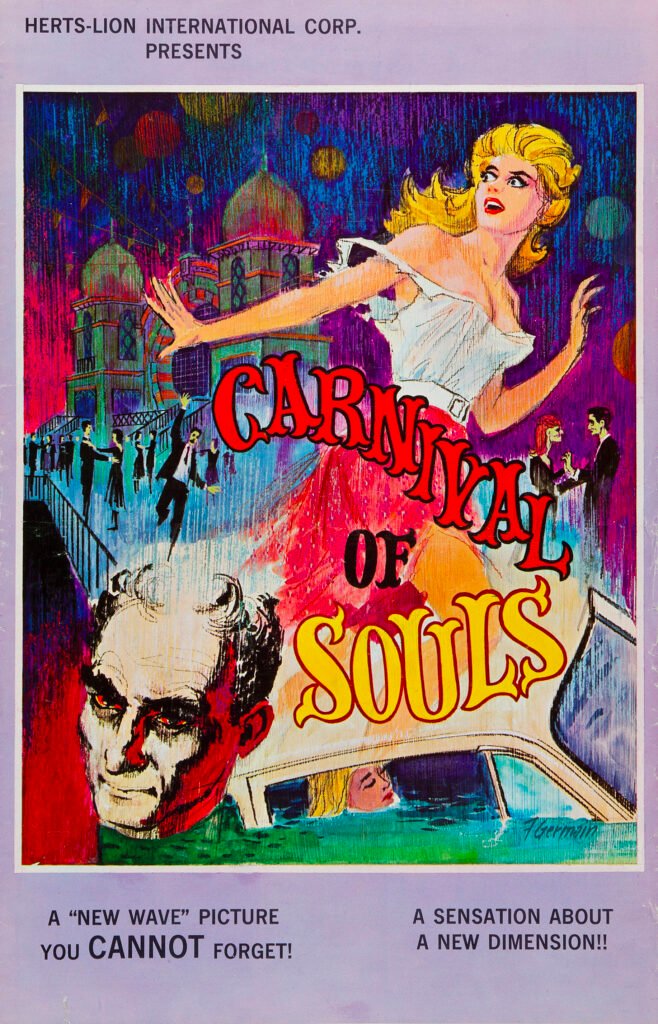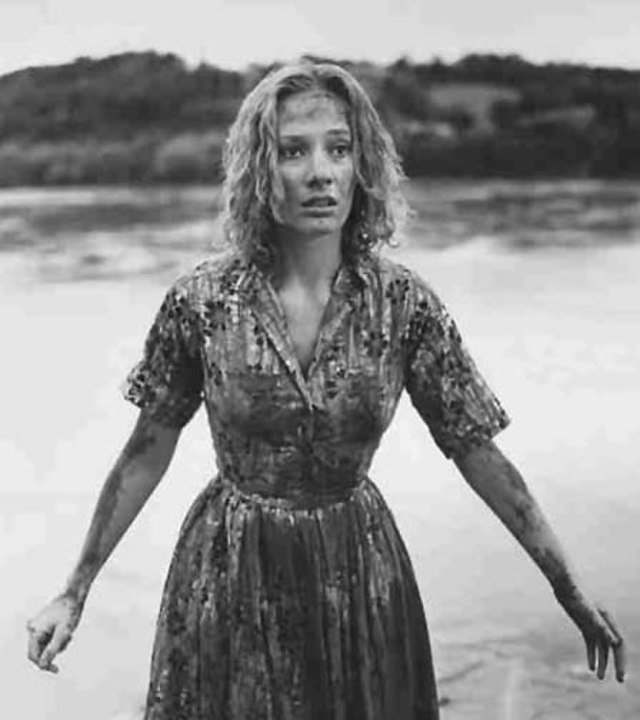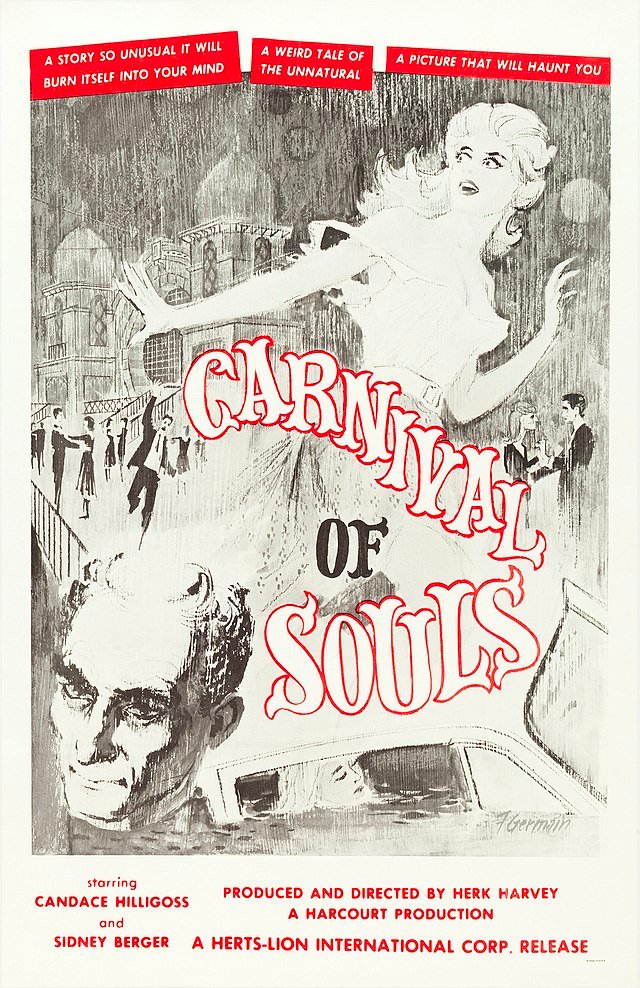
Carnival of souls
USA, 1962
Genre: Suspense, horror
Director: Herk Harvey
Screenwriter: John Clifford
Soundtrack composer: Gene Moore
Production: Herk Harvey (Harcourt Productions)
Cinematography: Maurice Prather
Starring:
Candace Hilligoss (Mary Henry)
Frances Feist
Sidney Berger
Art Ellison
Stan Levitt
Tom McGinnis
Forbes Caldwell
Dan Palmquist
Bill de Jarnette
Pamela Ballard
Plot
Four girls in a car are challenged to a race by some young men in a car. When both vehicles cross a bridge, the girls’ car loses control and falls into the river. As members of the rescue team search for the wrecked car and try to find survivors, a woman emerges from the water: it is Mary Henry, one of the four girls in the car that plunged from the bridge.
Dazed, Mary can’t remember anything. The next day she decides to leave the city for a town in the state of Utah. There she will work in a church as an organist. On the way, on the road, she sees the spectral face of a man in the window and soon after also in front of her. The apparitions take place when Mary was passing near a large, abandoned-looking pavilion.

At the next gas station, the young woman asks what this mysterious building is. They explain to her that it is an old amusement park where carnivals and other festive events used to be held years ago…
Mary arrives at her new lodging, a boarding house run by Mrs. Thomas where only two tenants reside: She and Mr. Linden, who sleeps in the adjoining room. Shortly after settling in, Mary sees again that night the same ghost that appeared to her on the road.
The next morning the young woman reports to her new place of employment; the township church. There her task will be to play the organ during the masses. The parish priest offers her to attend a welcome party, but Mary does not seem very enthusiastic about the idea: she is a very lonely woman who prefers not to have too many social contacts.
While the organ is playing, the same being from beyond the grave of her visions comes to the church, although this time with a more material and corporeal appearance. But Mary does not see it.
The organist is interested in visiting the abandoned pavilion and asks the priest to accompany her there. The priest agrees, but refuses to go inside. Mary feels a deep curiosity to discover the mysteries that this place hides.
Later, at the boarding house, Mary receives a visit from her neighbor John Linden. This is a born conqueror, a gallant who does not miss the opportunity to invite her to dinner. Initially the girl prefers to keep her distance. Soon after, when John has left, Mary sees another man on the stairs of the inn: again the same ghostly individual, but now embodied and material instead of ethereal, blurred and fleeting as in her visions. The undead is so real that Mary reacts with hysterical dread. The boarding house manager does not understand the young woman’s irrational behavior, for apart from the two of them and Mr. Linden there is no one else there.
The next day, John visits her again and continues to try to seduce her. He is a humble, uneducated worker, but a great expert with women. Mary goes shopping in the city and has a strange experience: When she leaves one of the fitting rooms in the store, she is astonished to find that everyone ignores her. No one seems to be able to see or hear her. Upon returning to her normal state after a long and distressing period of indeterminate time, Mary meets by chance a psychologist; and goes with him to his office for a therapeutic session. The young organist tells Dr. Samuels of the distressing incident she has just suffered: “It was as if I didn’t exist” and of her visions of the living dead: “That man follows me everywhere…”
Mary decides to return alone to the abandoned pavilion, and this time to go inside. She is convinced that there she will find the key to her hallucinations…

Comment
This little gem that masterfully combines the psychological thriller with the paranormal is a great discovery. Like “Dementia 13” (1963), Francis Ford Coppola’s debut film, “Carnival of Souls” is a perfect showcase of early 1960s American independent cinema – proving that it is possible to make memorable works with meager means if you have talent and a good story to tell.
Returning to her church job after investigating the abandoned amusement park, Mary is seized by a strange force while playing the organ. The priest dismisses her, accusing her of “profanation and sacrilege”, mentioning that she seems to “no longer have a soul”… Since the car accident in the opening scene, and especially after entering the carnival pavilion, both Mary and everything around her becomes more and more disturbing…
The film has very good dialogues, especially in the somewhat conflicting moments between John and Mary – he tries to win her over, but her distant and cold character is a major obstacle: “You don’t like to drink, you don’t like to dance, you don’t like to have a man around…” “I didn’t say that” “You haven’t said anything all night”… In front of the psychologist, Mary admits that sometimes she feels like “she’s not from this world”.
The film that we review today has served as inspiration to David Lynch and George Romero, as they themselves have recognized (we can see where Romero got the idea for the aesthetics of his living dead). It is also very interesting to observe the enormous parallels between “The Carnival of Souls” and “Door into silence” (1991), the last film by Lucio Fulci (which is so different from the rest of his filmography). The sex of the protagonist changes (in Fulci’s film it is a man) and some other details, but the plot and the treatment of the same have enormous similarities: The car accident, the main character becomes more and more paranoid, hallucinations increase, the claustrophobic atmosphere becomes denser, it is increasingly difficult to discern between reality and fiction; between the “safety of daylight” and the dark and demented nightmare. And above all: it is increasingly difficult to distinguish between life and death….
Also worth mentioning are the soundtrack and the exquisite black and white photography, which enhances the visual power of the proposal.

“Carnival of souls” is the only feature film by its director Herk Harvey (1924-1996), who besides this film only made short films and the occasional documentary.
Get Carnival of Souls HERE!
(This is an affiliate link. I may earn a commission if you purchase through these link, at no extra cost to you. As an Amazon Associate, I earn from qualifying purchases.)

